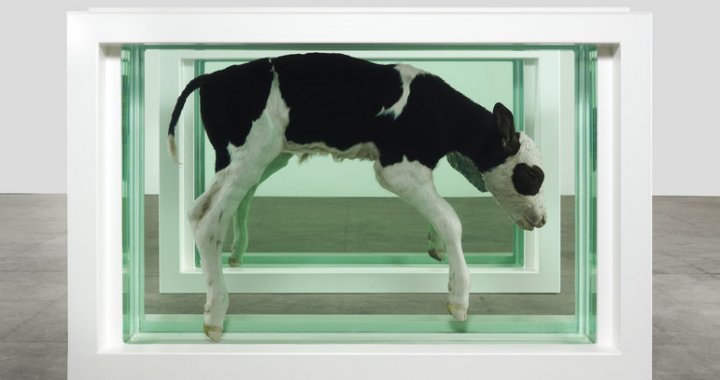
Cow on the Beach
Bruno Dumont’s P’tit Quinquin meets Damien Hirst
By
14/09/2016
1.
‘Holy shit!’ ‒ repeats the bewildered museum-goer staring at a contemporary art installation. Something along these lines is also muttered by Commandant Van der Weyden as he stands contemplating the scene of yet another murder, each one more bizarre than the last.
All the victims ‒ Madame Lebleu and her lover, found inside the body of a dead cow; Monsieur Lebleu, shot dead at his own farm; the neighbours’ daughter, devoured by their pigs, and, finally, the owner of the dance club (she is also the ex-lover of M. Lebleu), frozen into a grand installation ‒ are connected by an invisible thread.
In fact, where the classic detective story surrenders itself to investigation (the soothing routine of details, unhurried verification of facts and synchronization of watches), ‘P’tit Quinquin’ is pointedly actionless, compensating for the lack of a spectacle of intellect with looking.
‘C’est bordelle!’ ‒ the Commandant never tires of repeating while staring at yet another cow, Mme Campin pretending to be a seaside example of land art, or at the juvenile gang of Quinquin, sucked into this visionary performance just like himself.
The effect of this indecently dragged-out episode is almost the same as of the little scene at the museum, the only difference being the fact that Commandant Van der Weyden is contemplating the murder of a local farmer, while the victim in front of the visitor of the museum is traditional art. Furthermore, both leave the respective scenes convinced that the Author, sadly, is dead.
Of course, the rhyme (crime ‒ art) is not a new one for the genre of detective fiction. By examining the murder, the detective was able to assess the ‘taste’ of the criminal (whose career was effectively built according to the same rules as that of an artist: seriality; variations on the same motif; development of the theme ‒ movement towards the final opus, the inevitable crescendo of the whole composition). However, in stories about maniac killers whose compulsive need for order was naively asserted through aesthetics (be it the culinary art of Hannibal Lecter or Argento’s Baroque-obsessed characters), crime-as-an-art-form was validated by the object-artwork.
In ‘Quinquin’, the body is mostly absent (no Grand Guignol here; the main evidence is represented by a pig and a cow). The camera artlessly turns away from the victims, relaying to us the Commander’s look exclusively: astonished and confused, it is the look of a man incapable of perceiving the very rules by which he is supposed to play now ‒ or, to be more precise, the very discourse of his anonymous vis-à-vis with a circular saw and a touching love for Flemish art.

2.
The very fact that Dumont has chosen a cow betrays irony ‒ unconscious irony perhaps, but definitely a cultural one. Damien Hirst’s famous installations with cut-up cows in glass cubes were an ironic attack on minimalist sculptures (with their solipsist images escaping anything remotely similar to descriptiveness), positivist knowledge (the world like a giant cabinet of curiosities) and religion (by literalizing Christian symbols like ‘the black sheep’ and ‘the golden calf’). Simultaneously, they involved in this game the element of the viewer’s gaze, which was asked to conceive the inconceivable. [i]. After all, working exclusively with live ready-mades, Hirst coupled art with crime, taking this couplet to indecent literalness. Of course, Dumont’s dissected cow turns out to be nothing more than a container for a character (also dismembered). And, while Hirst polemicizes against minimalist art (against the utopia of Judd or Morris), Dumont tackles the detective story. However, as far as the actual practice of deconstruction is concerned, there is no fundamental difference between the two of them. In both cases, it is ratio ‒ reason ‒ that becomes the target.
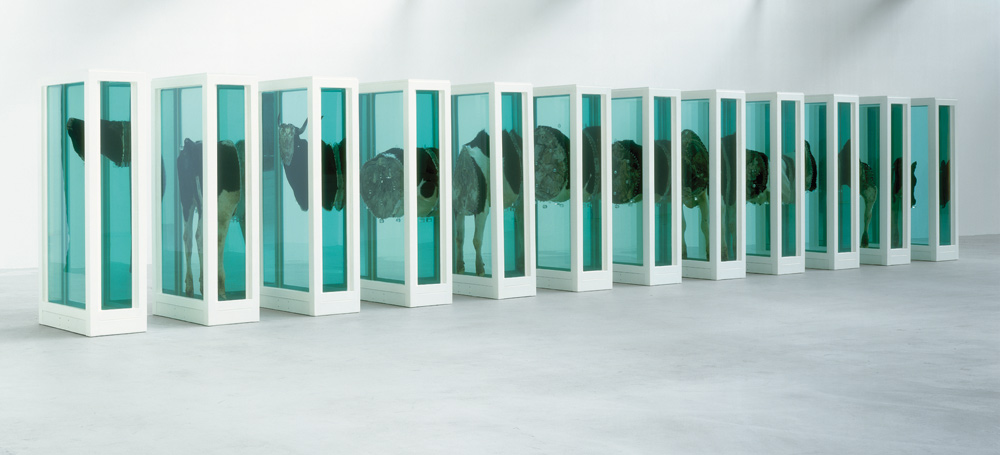
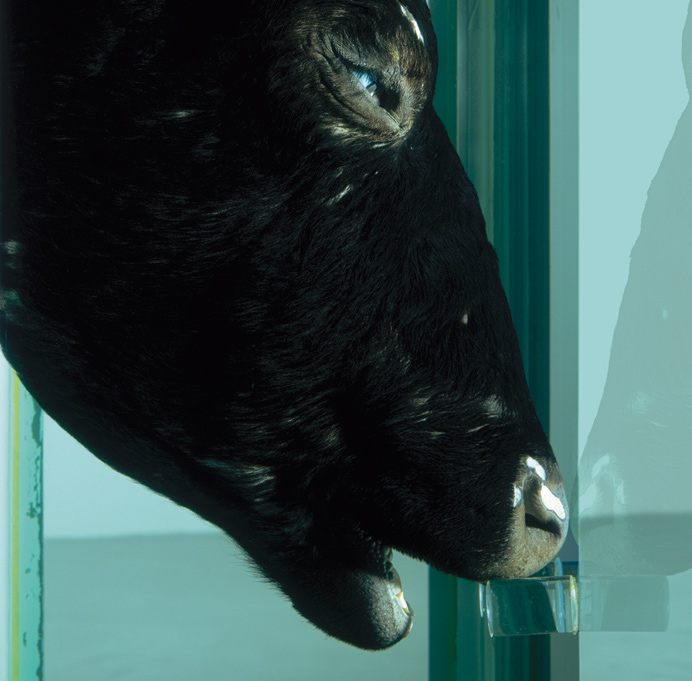
Damien Hirst. Some Comfort Gained from the Acceptance of the Inherent Lies in Everything. 1996. Steel, glass, cows and formaldehyde solution (12 tanks). Each tank: 200 x 90 x 30 cm. Photo: www.saatchigallery.com
While Judd’s empty glass boxes, placed in an empty space, play out the triumph of intellect, the devastating domain of a solitary illusion, for Hirst the glass is no more than an aquarium (or perhaps the index of an aquarium). By colliding the artificial and the natural, the figural and the abstract, the Juddian cube and the body of a cow (dead but not irrevocably so), Hirst immortalises the melancholy of intellect, breaking a crack in the abstract art.
The latter does not manage to coincide with his own image ‒ get rid of the notorious addition of reality, of the element of fortuity introduced by (the inherently ambiguous) intellect itself. In other words, where Morris and Judd turn a blind eye to the inevitability of ressentiment, excluding the object from any connections at all (demanding emptiness, renouncing the narrative, non-literality and, effectively, dreaming of being neither a thing nor art [ii]), Hirst goes and involves them in a dialogue again. After all, if the minimalist object forgets about the hand (as if emerging from nothing and stating nothing: the famous Morrisean cube was just a reflection of the landscape), then the cow, born into the world by nature’s ‒ or God’s, if you like ‒ will, turns out to be as ‘miraculously created’ [iii]. On the other hand, it would be equally fair to say that it is not Morris or Judd who are the target for Hirst but Bauhaus and avant-garde instead ‒ that the transparency of the glass signifying primordiality, emptiness and nothingness, this ‘dispassionate nature of art’, undermines the ‘primordiality’ of the cow (not as a body but as a sign). And in this case, the actual emptiness and transparency become a mere utopia and deception, a beautiful attempt to hush up the doubling, get rid of the omnipresence of the signified – of the index.
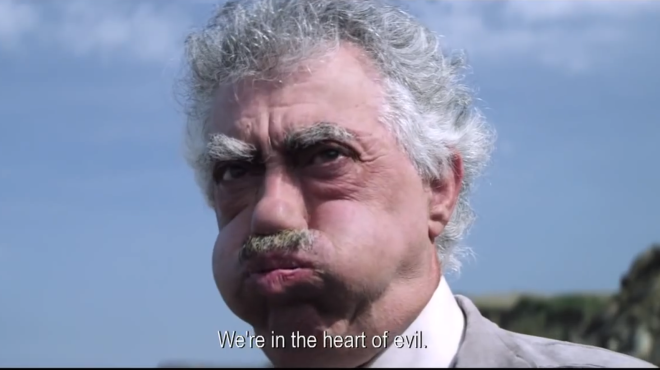
3.
In a way, it actually is the perfect crime – without a dead body presented to the public and, most importantly, without a murderer. And was it not the perfect crime that the detective genre had been cultivating by creating a character whose murder was a pure exercise in wit, expenditure, sublime contemplation lacking any pragmatism? Was it not the perfect crime that was unconsciously chosen as the ultimate goal by the genre whose plot – the mandatory movement from evidence to evidence ‒ was never anything more than just a catch of the storyline, something that safely concealed the crime of a consciousness that does not serve anything more than that, a gaze narcissistically turned towards itself, an intellect occupied not with the sublime or the most important but with the vain and the insignificant? It is no accident that, looking at the victim on the beach, Dumont’s Commandant reminisces about the Flemish masters who 'used to paint voluptuous bodies’. Contemplation prevails over professional instinct, while the place of the extravaganza of rationality, mandatory for the genre, is taken by muteness.
‘Sacred means sacred’; ‘Holy shit’; ‘This is hell’; Carpentier’s circling in a car: ‘P'tit Quinquin’ is consumed by endless tautology. But let us reiterate. The actual crime without a goal, without any obvious pragmatism behind it – and now even without a murderer: is it not a natural development of the story of Jack the Ripper who ‒ like his contemporary novelist ‒ arranged everything in series, introducing into the world the famed purity of order? In other words, wouldn’t it be more accurate to say that, by breaking the rules of the detective story, Dumont inconspicuously reveals its secret ‒ that, by disregarding the conditionality of the genre, he says: ‘A skilled master does not leave any evidence.’ If you want murder to be considered an art form, it does not have any need for the author (at least not to admire or contemplate him).
And that is the gist of Dumont’s humour. What was presented as a quirk in the classic detective story ‒ Holmes’ morphine and violin, Nero Wolfe’s orchids and passion for sophisticated and substantial dining or Hercule Poirot’s visits to his tailor, these almost mandatory whims that serve to distract almost every great detective from their investigation, creating pauses during which the intellect (or the body?) embraces pure hedonism ‒ here unexpectedly takes the spotlight. The marginal, the peripheral transforms into an end in itself. A secondary pleasure becomes the main thing.
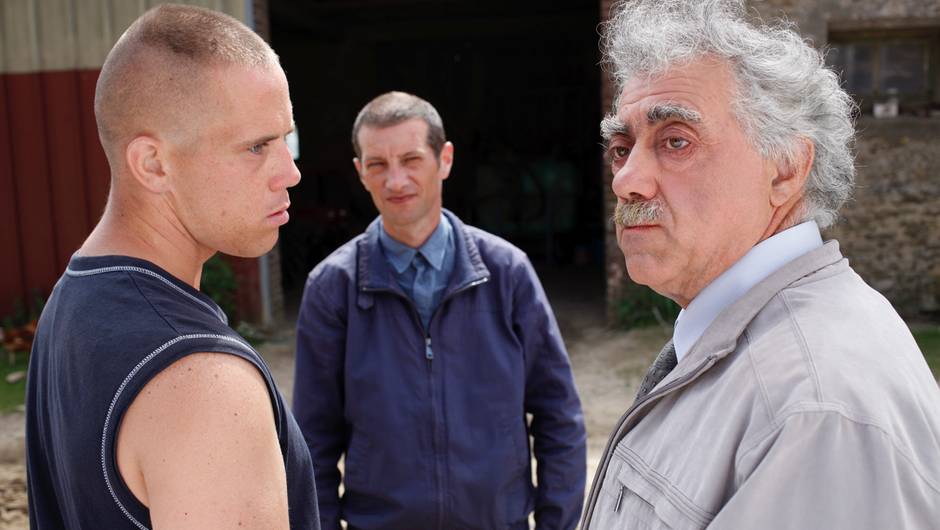
4.
The detective’s pleasure, dragged to light, makes time disappear. The obsession with time that, in a detective story of the classic variety, assembles life from bits and pieces, making it rational, comprehensible, intelligible, is sacrificed in favour of contemplation in ‘Quinquin’.
Not that it is anything surprising. In Dickens and Conan Doyle, in Chesterton and in Poe, passion for description, for methodical record-keeping and clever details served as a shield from the present. The endless catalogues attested to the solidity of the individual world, created its visual copy (and the area of its origin is immaterial, be it the history of atlases, parallel to the human one, or the kingdom of butterflies). In other words, they satisfied the need for a fundament, a foundation to which the reason could hold on.
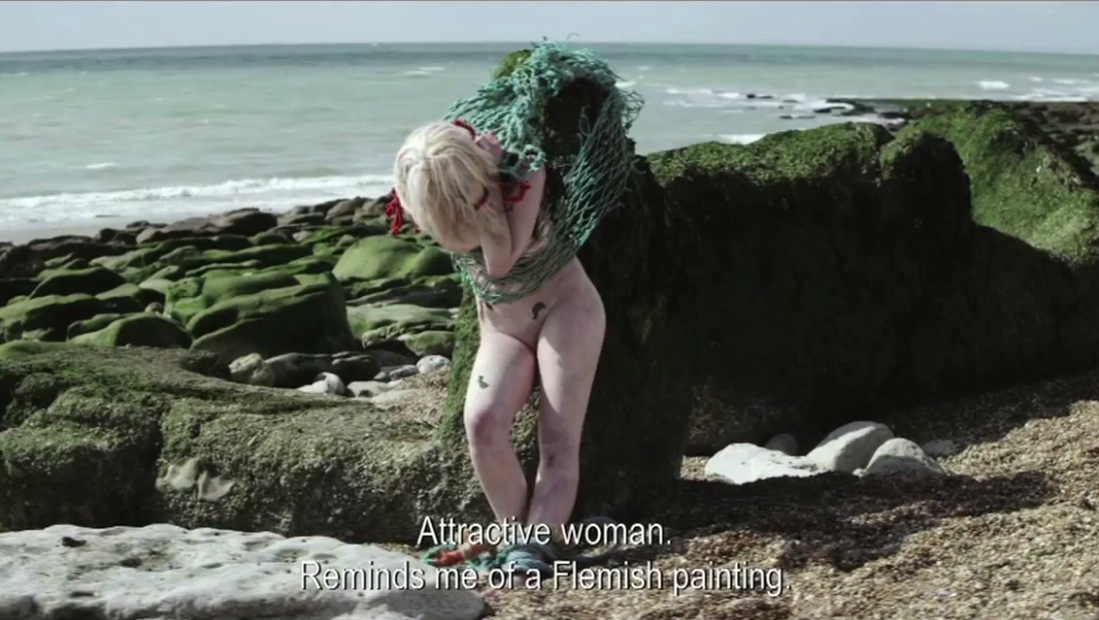
In Dumont’s detective story, there are no ‘universal rules’, no common ground ‒ with the possible exception of the landscape. The world consists of autonomous elements correlated based on the principle of solitude. It could almost have stepped out of television (the equally disparate world of Rubens and Marvel Comics, cheerleader girls and mulish French peasants, lacking any strictly defined coordinates). Each of the characters lays claim to its own separate existence. Furthermore, the rules of the narrative, the distinctive Dumontian syntax (with its transitions from close-ups to extreme long shots), insist that each action exists simultaneously with a hypothetical double; each storyline, while formally belonging to contemporaneity, unfolds in situational time, as opposed to chronological one. In other words, this has nothing in common with the traditional detective story (with its preoccupation with time, verification of hypotheses and cult of the detail). This is ruled out by the very principles of editing ‒ the banishment of the classic narrator who could have attested to the objectivity of the outside world.
So what is it that we are left with here? Why, it’s the same old Dumontian experience. [iv]. While in his earlier work Dumont refrained from using types, insisting on Adamic opaqueness of his characters, robbing them of names and professions, in ‘Quinquin’ the very genre of the piece prompted him to reinstate these attributes. The comic dimension seems to authorize ‘wholeness’, gives permission to take the experience of ‘being someone’ to its logical (or linguistic) limits. All of the roles (the peasant, the dancer, the Spiderman, the halfwit Dany) ‘fulfil themselves’ to the end ‒ intensify the functionality of the human (or inhuman) element, taking to the domain of the pure sign. Thus, at some point, Spiderman actually does attach himself to the barn. And Dumont does not disavow the trick; he does not announce that it is just a joke and the boy is only a costume-wearing cousin of Terrier’s daughter. The dancer dies ‘on the stage’, creating a live nature morte with the sea and the boulders. Terrier’s daughter, who was rude to an African guy, will dissolve in the barn, leaving behind not only her ‘Cause I Knew’, performed at the memorial service in church, the pigsty and the provincial talent contest, but also a soft musical accompaniment, reminiscent of Pasolini’s offscreen Bach. The immediate association is his ‘Porcile’ (‘Pigsty’), and the rhyme works. Because the logic of the detective story here operates on the symbolic level: everybody who commits a sin against virtue will die. The notorious experience will be taken to its limits and exhausted. Effectively, you could say that the sacrificial victims actually offer themselves for immolation and, obeying their moral obligation, voluntarily disappear in the carcass of the cow.
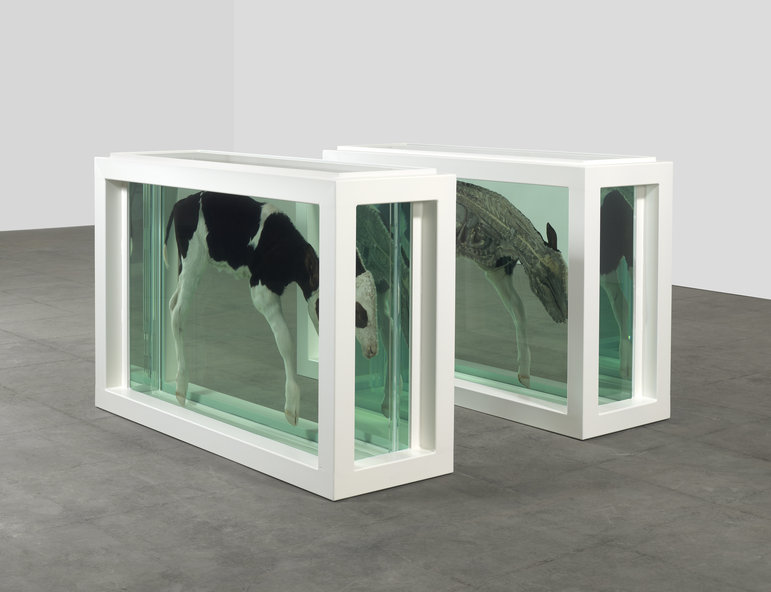
Damien Hirst. The Prodigal Son. 1994. Glass, painted steel, silicone, acrylic, plastic cable ties, stainless steel, calf and formaldehyde solution. Two parts, each: 991 x 1499 x 483 mm. Photo: www.damienhirst.com
In other words, ‘Quinquin’ is an ironic parody of the ‘autonomy’ of reason that is crucial for the genre. And while the latter was a reaction on the natural process of isolation and detachment, including from one’s own self-perception ‒ while one of the reasons why the detective genre relied on the intellect so much was its unconditional faith in the body, this traumatic distance between reason and emotions, the human and the mechanic, the oh-so sensitive line between the one and the other does not seem as important today. Despite the laments of the classics of simulacrum, we have nevertheless found ourselves in a world where a virtual body has merged with a sensitive intellect. And at this point it is very interesting to go back to Hirst. A long time ago, the viewer was impressed by his combinations of the quasi-living with the quasi-dead, the quasi-natural with the quasi-artificial. The reason behind the striking impact of his installations was the fact that the viewer ignored the ‘quasi’ part. Today, viewing the same sharks and cows, the public knows that the objects it sees are actually copies instead of the originals.
They know that a living cow is nothing more than the index of a ‘living cow’. And this outward-bound movement, this flight seems as fascinating as the one before ‒ possibly for the reason that it reveals the melancholy of any ‘immediacy’.
[i] The selfsame ‘Physical Impossibility of Death in the Mind of Someone Living’.
[ii] As ‘Californian’ (according to Rosalind Krauss) as the accent of Judd’s installations is, it is likewise obvious that the minimalist object strives to sabotage the meaning; it wants to be a non-sculpture and a non-landscape; a non-thing and a non-art. What it actually does is lay claim to take the place held by God in the apophatic theology, as something that is only described by negation and defies any definitions ‒ in other words, despite the functionality of Judd’s shelves, does not exist.
[iii] I a priori depart from the ‘classic interpretation’ of Hirst where the cow, having died but never existed as dead, is the antagonist to the pure abstraction of the cube and where the emphasis is exclusively on the clash between the living and the dead.
[iv] The actual verbalization of experience, its validation through language, as before, is still absent in Dumont. For this reason, the traditional explanation offered by the detective to the audience, the final speech that reveals the meaning of the crime, dotting the i’s and crossing the t’s, is replaced by truisms, by tautology in ‘Quinquin’: ‘This is hell, my friend, this is hell.’